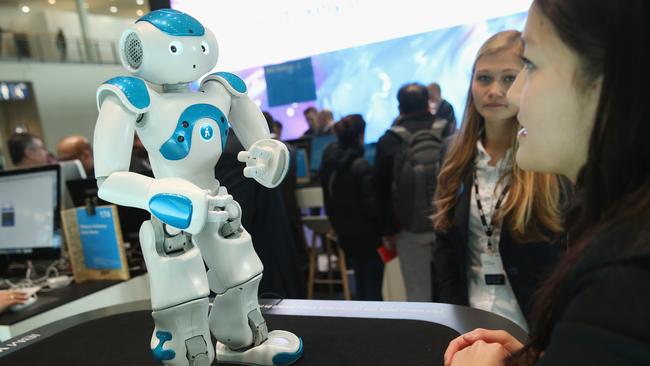MediaConnect tech conference: NBN, STEM and Watt’s what
IBM’s supercomputer Watson is analysing up to 50,000 news stories a day to work out Australian journalists’ interests.

IBM’s supercomputer Watson is being harnessed to analyse the writing interests of Australian journalists in what is a most unusual project in public relations.
Watson became famous in 2011 when it beat humans in American television quiz show Jeopardy. Last year IBM made available for public use 19 cognitive services that are part of Watson’s talents. This included its natural language processing capability.
People can go to IBM’s Watson site and try applications for themselves.
Australian firm MediaConnect took up the Watson challenge and says it is funnelling 20,000 to 50,000 stories a day from Australian online news sources into the supercomputer.
That number might look ridiculous but Mr Sim insists that when you factor in all publications (from different Australian regions and various genres), it’s the case.
“It obviously ranges. 50,000 is the top of the range and that is the number we work to as we have to scale to that. Average is between 30,000 and 40,000. A quiet day can be down around 20,000,” he said.
After considerable cogitation, Watson is spitting out a taxonomy of journos and the topics that interest and energise them.
It’s part of a plan to automate the delivery of media releases to journalists. Soon bots will select information to be sent to each journalist based on Watson’s taxonomy of their interests.
“The next step is to automate the delivery of news and (press) releases based on intelligence,” MediaConnect founder Phil Sim tells The Australian.
The MediaConnect system uses a combination of artificial intelligence, machine learning and natural language processing.
“Over time, the system gets smarter and smarter at identifying which categories it (a story) should be dropped into and subsequently which journalist should be receiving what information,” Sim says.
“A big part is also putting the real-time chat layer over the top of it so that a journalist just isn’t delivered a story, they can go into real-time discussion with a spokesperson or the PR person.” Sim says the chat facility will launch this month.
Sim says he uses the supercomputer’s natural language capability, but one wonders at the potential if you ran all these stories daily through Watson’s personality insights engine or tone analyser - what you might discover about the state-of-mind of journalists as they wrote those 50,000 stories, or in Watson-speak their “detailed personaility portraits”. Someone is bound to try this sooner than later.
MediaConnect also hosts an annual “tech leaders” conference in the Blue Mountains west of Sydney for national tech reporters and information and communications technology businesses.
This year’s event was held a few days ago and local member for Lindsay Fiona Scott delivered the government keynote address. It’s a departure from recent years; usually the Coalition offers up MPs with a specialist technology role.
Scott couldn’t answer several broader questions but she did read a speech about the poor rates of student participation in science, technology, engineering and mathematics subjects, the government’s innovation and science agenda, and her local initiatives such as the Werrington Park Corporate Centre in western Sydney.
Her most pertinent comments related to the lack of women in senior IT positions, programming and technical support. “We cannot afford picking our team from half the available players,” she said. That lack of participation became apparent when the room realised she was the only female speaker out of more than two dozen presentations across two days.
Opposition communications spokesman Jason Clare declared musical instrument counterfeiter and steam engine adaptor James Watt the most important person who ever lived because the Watt steam engine led to the creation of factories, mass production, railways, mass transportation and modern civilisation.
Clare said Australia’s broadband speed had fallen behind that of some eastern European countries. “Three years ago we were ranked 30th in the world for broadband speed,” he said. “We are now ranked 46th. We are behind most of Asia and most of Europe, the US and Canada. We are even behind Romania, Russia, Slovakia and Poland.”
In the past 2½ years, he added, the cost of the National Broadband Network had almost doubled from $29.5 billion originally promised by the Prime Minister to $56bn.
Clare wasn’t the only one lambasting the NBN. MyNetFone chief executive Rene Sugo said the NBN risked becoming increasingly uncompetitive with mobile internet. Sugo, a long-time outspoken critic of NBN’s wholesaling structure, released figures that he said were based on NBN’s 2015 corporate plan.
He said when you factored in a variety of costs, the average retail selling price for services from a typical small to medium-sized telco would go from $49 a month to $82.50 for a 12 megabit per second plan, and from $59 a month to $95 a month for a 25Mbps plan in 2020.
In contrast, mobile internet was increasingly competitive. Sugo predicted that by 2020, mobile broadband plans of 100 gigabytes-plus would be available for $49 a month.
“At what point will consumers stop bothering with a fixed broadband service and go mobile only?” he asked.
Intelligent Business Research Services (IBRS) adviser Joseph Sweeney discussed digital disruption and investment. He said Australia had a “cultural problem” with reinvesting savings from technology back into businesses.
“When you look at Australia’s history of reinvesting in the business — taking profits and ploughing them into technology, by western standards we have very low reinvestment in business. And that’s a cultural issue,” Dr Sweeney said.


